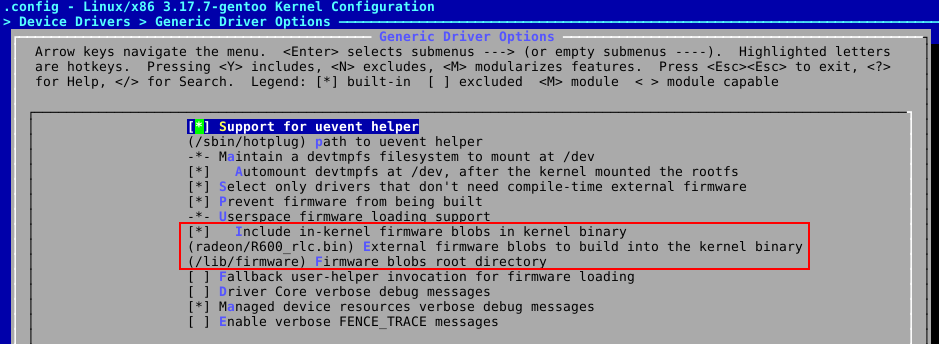Installing Xorg and Xfce on a Gentoo Linux laptop.
Before We Begin
This article is my personal notes on installing an Xorg X window system and an Xfce lightweight desktop environment on a Gentoo Linux on a Dell Studio 1535 laptop. This article is not intended to be a step-by-step guide. You may want to visit the Gentoo Wiki for documentation and more information.
What does this article cover:
- Installation of Xorg
- Installation of Xfce
- Installation of some Xfce plugins
Hardware
The laptop has an ATI Mobility Radeon HD 3450 graphics card:
$ lspci | grep VGA 01:00.0 VGA compatible controller: Advanced Micro Devices [AMD] nee ATI RV620 [Mobility Radeon HD 3400 Series]
Xorg Installation
Kernel Modification
This assumes you use Linux kernel v3.17.
Activate support for evdev:
Device Drivers –> Input device support –> Event interface (*)
Prepare the kernel for KMS:
Device Drivers –> Graphics support –> Frame buffer devices –>
## (Disable all drivers, including VGA, Intel, nVidia, and ATI)
Configure the kernel to use the proper KMS driver for an AMD/ATI video card and enable Radeon KMS support.
# emerge --sync # emerge --ask x11-drivers/radeon-ucode
Kernel modifications:
Device Drivers –> Generic Driver Options –> Include in-kernel firmware blobs in kernel binary (*)
Device Drivers –> Generic Driver Options –> (radeon/R600_rlc.bin) External firmware blobs to build into the kernel binary
Device Drivers –> Generic Driver Options –> (/lib/firmware) Firmware blobs root directory
Device Drivers –> Graphics support –> Direct Rendering Manager –> ATI Radeon (*)
Recompile and install the kernel (should take a couple of minutes only):
# cd /usr/src/linux # make && make modules_install install
make.conf Configuration
Add the following to the /etc/portage/make.conf:
# (For mouse, keyboard, and Synaptics touchpad support) INPUT_DEVICES="evdev synaptics" # (For AMD/ATI cards) VIDEO_CARDS="radeon"
The example below is for a system with a keyboard, mouse, Synaptics touchpad and a Radeon video card:
# emerge -pv xorg-drivers ebuild R ] x11-base/xorg-drivers-1.15 INPUT_DEVICES="evdev synaptics -acecad -aiptek -elographics -fpit -hyperpen -joystick -keyboard -mouse -mutouch -penmount -tslib -vmmouse -void -wacom" VIDEO_CARDS="radeon -apm -ast -chips -cirrus -dummy -epson -fbdev -fglrx (-freedreno) (-geode) -glint -i128 (-i740) -intel -mach64 -mga -modesetting -neomagic -nouveau -nv -nvidia (-omap) (-omapfb) -qxl -r128 -radeonsi -rendition -s3virge -savage -siliconmotion -sisusb (-sunbw2) (-suncg14) (-suncg3) (-suncg6) (-sunffb) (-sunleo) (-suntcx) -tdfx -tga -trident -tseng -v4l -vesa -via -virtualbox -vmware (-voodoo)" 0 kB
Install Xorg
Make sure udev is in our USE flags:
# echo "x11-base/xorg-server udev" >> /etc/portage/package.use
Install Xorg (this may take a while):
# emerge --ask --quiet xorg-server
When the installation is finished, update environment variables before continuing:
# env-update && source /etc/profile
Restart the system in order to boot the new kernel.
That’s it, try startx to start up an X server. It should work out-of-the-box without a need to manually edit Xorg’s configuration files.
As the Gentoo Wiki says:
“If you haven’t yet installed a window manager, all you’ll see is a black screen. Since this can also be a sign that something’s wrong, you may want to emerge twm and xterm only to test X.
Once those two programs are installed, run startx again. A few xterm windows should appear, making it easier to verify that X is working correctly. Once you’re satisfied with the results, run emerge –unmerge twm xterm as root to get rid of the testing packages. You won’t need them once you’ve setup a proper desktop environment.”
Xfce Installation
USE Flags
Check your USE flags (for more info, see here https://www.gentoo.org/dyn/use-index.xml):
# grep USE /etc/portage/make.conf USE="-gnome -kde -minimal -qt4 -systemd bindist mmx sse sse2 dbus jpeg lock session startup-notification thunar udev X"
You may need this:
# echo "sys-fs/udev gudev" >> /etc/portage/package.use
Install Xfce
Install Xfce (this may take a while):
# emerge --ask --quiet xfce4-meta
Install a graphical terminal:
# emerge --ask x11-terms/xfce4-terminal
Some Xfce plugins I use:
# emerge --ask xfce4-battery-plugin xfce4-datetime-plugin xfce4-mixer \ xfce4-notifyd xfce4-power-manager xfce4-screenshooter xfce4-weather-plugin \ xfce4-xkb-plugin
You may need this:
echo "sys-auth/consolekit policykit" >> /etc/portage/package.use
You can check for more available Xfce plugins:
# emerge --search xfce4 | less
Optionally, install Firefox:
# emerge --ask --quiet firefox
You may need this:
echo "dev-lang/python sqlite" >> /etc/portage/package.use echo "media-libs/libpng apng" >> /etc/portage/package.use
Update environment variables:
# env-update && source /etc/profile

